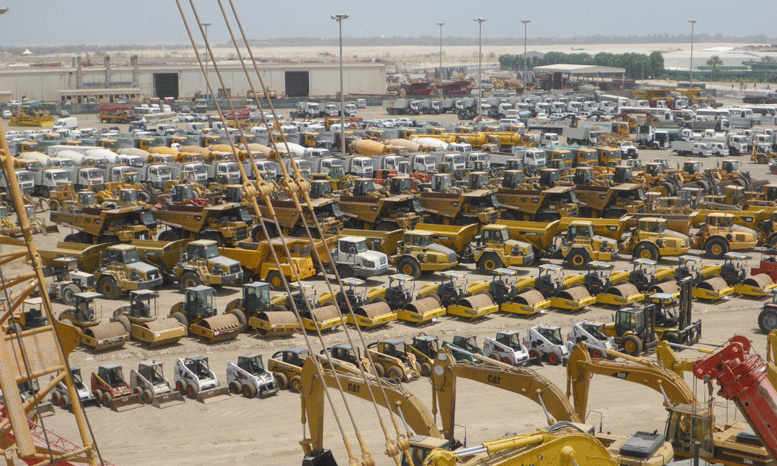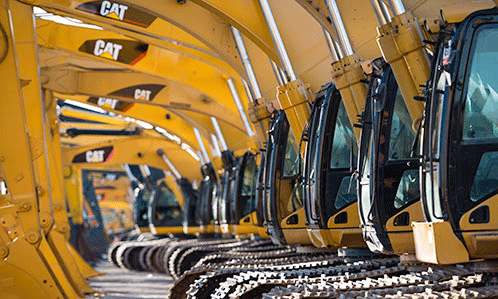After a turbulent few years, Europe’s used equipment market is finding its rhythm again. According to Ritchie Bros.’ latest quarterly report, the third quarter of 2025 shows a region not just recovering, but redefining what resilience means for the global machinery trade.
Europe’s heavy equipment and agricultural machinery sectors are entering a new phase of stability, according to the Ritchie Bros. Used Equipment Market Trends Report (European Edition, Q3 2025). The report, based on aggregated data from Ritchie Bros. auction transactions and Mascus listings, highlights a period of measured growth following mid-year slowdowns, and signals a broader structural shift in how equipment is bought, sold, and managed.
By late 2025, the used market has transitioned “beyond recovery into a phase of reconfiguration,” the report notes. Construction equipment is leading this transformation, compact machinery remains a standout performer, and agricultural equipment continues to consolidate amid challenging margins.
Buyers, meanwhile, are becoming more pragmatic and data-driven, prioritising younger, cleaner, and more efficient machines, even at higher upfront prices. Sellers, on the other hand, are benefiting from improved liquidity, strong resale values, and revived cross-border demand, an encouraging sign of market health across the continent.
“The used machinery market is stabilising, but not stagnating,” says a Ritchie Bros. analyst. “We’re witnessing a recalibration, where buyers are selective, sellers are strategic, and transactions are increasingly digital.”
Construction Leads the Comeback
In the construction sector, Ritchie Bros. and Mascus data converge on one clear narrative: demand is back, and it’s focused on quality.
Articulated Dump Trucks (ADTs) Rebound Strongly
Articulated dump trucks (ADTs) posted one of the most dramatic rebounds of the quarter. While listings dropped by 8% compared to Q3 2024, buyer enquiries rose by 11%, signalling robust demand outpacing supply. Auction data confirmed the upswing, with sales volumes up 79% and median prices climbing to €42,712, a 5% year-on-year increase.
Volvo maintained its dominant position across both listings and auction sales, with the A40G model leading transactions at a median price exceeding €143,000. The United Kingdom, Belgium, and the Netherlands were the most active buying markets, collectively accounting for over half of all European ADT sales.
This trend reflects renewed infrastructure and quarrying activity in Western Europe and underscores a wider fleet-modernisation push. Younger, fuel-efficient haulers are increasingly favoured for their reliability, telematics integration, and lower operating costs; key priorities for large-scale contractors and rental houses alike.
Crawler excavators remain the backbone of Europe’s used equipment market, maintaining both steady pricing and high turnover. Auction sales rose 35% year-on-year, with the median price inching up by 1% to €31,078.
The segment’s stability reflects disciplined purchasing patterns with fewer speculative buys, and more targeted acquisitions. Hitachi, Caterpillar, and Komatsu led auction volumes, while Volvo’s EC140EL stood out as the most popular model, selling 11 units at a median of €71,510.
Demand was strongest in the United Kingdom, Spain, and Belgium, markets where infrastructure and civil-engineering investments remain resilient. A consistent median machine age of seven years suggests that buyers are seeking a balance between affordability and reliability—an indicator of maturity in the secondary market.
The report identifies mini excavators as the most dynamic segment in Europe, continuing a multi-year trend driven by urbanisation, utility projects, and rental fleet renewal.
While listings dipped by 2%, buyer demand soared 27%, and auction sales climbed 10% year-on-year. The median price rose modestly to €11,836, and usage hours dropped sharply, showing that newer, lower-hour machines are commanding stronger interest.
Yanmar led auction volumes, followed by JPC and Kubota, while the JPC HT12 emerged as the most popular model with nearly 200 units sold at a median price of just €2,506.
Germany, Italy, and Spain continue to be the most active buyer markets. Ritchie Bros. attributes the sustained performance of mini excavators to domestic demand – nearly 60% of sales occur within the same country – reflecting how compact, versatile equipment remains essential to small contractors, landscapers, and municipal works departments.

Wheel Loaders Maintain Steady Climb
Wheel loaders, a barometer for industrial and aggregates activity, recorded a 29% surge in demand and a 5% increase in prices over the previous year.
Auction data shows Caterpillar, Volvo, and JCB as the top sellers, while lesser-known brands such as Blanche and Machpro are gaining traction among cost-conscious buyers. The most popular model in Q3 was the Blanche TW36, with 12 units sold for a median of €5,519.
The Netherlands, Spain, and Poland led purchasing activity, demonstrating the strength of logistics and recycling sectors where wheel loaders are heavily deployed. Ritchie Bros. notes that replacement cycles remain healthy, indicating sustained investment even in a cautious macroeconomic climate.
While construction and compact machinery remain upbeat, agriculture is showing signs of restraint. Tractor listings rose 4%, but the median sale price declined 5% to €35,123, with machines averaging 11 years of age and 5,370 hours of use.
New Holland, Claas, and Deutz-Fahr dominated auction volumes, while John Deere remained the most searched brand on Mascus. However, tightening farm margins, higher input costs, and reduced subsidies are prompting operators to extend ownership cycles rather than expand fleets.
Activity in Spain, Germany, and France remains relatively steady, suggesting a regional pivot toward equipment retention and refurbishment rather than outright renewal.
Cross-Border Liquidity and Digital Acceleration
The report emphasises that cross-border trade is increasingly defining Europe’s used machinery ecosystem. Across all categories, between 40% and 60% of units sold now move between countries, underscoring the interconnected nature of the European secondary market.
This international mobility is being facilitated by digital auction platforms and data-driven trading tools, enabling buyers to compare pricing, usage, and residual values with greater transparency.
Ritchie Bros.’ own ecosystem, which includes Mascus listings, IronPlanet, Marketplace-E, and RB Auction, has positioned itself as a bridge between traditional auction networks and modern online marketplaces.
“Buyers and sellers are adapting fast,” says the report. “The combination of real-time data, multi-channel sales options, and trusted inspection systems is reshaping how equipment moves across borders.”
The Ritchie Bros. conclusion is that Europe’s used machinery sector is no longer defined by post-pandemic recovery, but by reconfiguration and readiness.
The growing appetite for low-hour, emissions-compliant models mirrors the direction seen in the Middle East and other developing markets, where fleet operators are increasingly aligning with international standards for sustainability and productivity.
For global buyers, including those in the GCC, Europe’s used equipment market remains a reliable source of well-maintained, high-spec machines with strong provenance and support histories.

Middle East: Sourcing Shifts Toward Europe?
While the report focuses on Europe, the implications for the Middle East are significant. Regional contractors and rental operators are increasingly turning to European suppliers to meet their fleet needs as new equipment lead times stretch and domestic demand surges.
Across the GCC, infrastructure megaprojects and oil diversification programmes. particularly under Saudi Vision 2030 and UAE Net Zero 2050 initiatives, are driving record demand for heavy machinery. But with OEM production still constrained and regional inventories tight, Europe’s stabilising used equipment market is becoming a vital source of supply.
Fleet Renewal and Rental Expansion
In Saudi Arabia, the construction boom linked to giga-projects such as NEOM and The Line is fuelling one of the fastest-growing rental markets globally. Companies like Dayim Equipment Rental, Bin Quraya, and eXpertise are investing heavily in fleet renewal, focusing on low-hour, high-efficiency models that offer reliability in extreme conditions.
Europe’s used equipment stock, particularly Volvo, Caterpillar, Komatsu, and Hitachi units. matches those criteria, making the continent a preferred sourcing hub for Middle East buyers seeking cost-effective, high-quality assets.
Another major driver is alignment with emission standards. As GCC nations introduce cleaner fuel mandates and sustainability benchmarks, demand is shifting toward newer Tier 4-compliant or Stage V engines, machines that often originate from the European resale market.
This mirrors Europe’s own pivot toward energy-efficient and hybrid equipment, as seen in the Ritchie Bros. data showing stronger prices for modern, low-hour units. Middle Eastern fleets, especially those serving government and oil sector contracts, are using this opportunity to modernise while maintaining cost control.
The digital infrastructure underpinning Ritchie Bros.’ European success is also being replicated regionally. Online auctions and real-time bidding systems now allow Middle Eastern buyers to participate directly in global sales, reducing friction and improving transparency.
CMME’s organisation of the Access and Handling Confex 2025 and Heavy Equipment Connect events has already shown a clear shift toward digital procurement and equipment-as-a-service models across the region further linking Middle Eastern buyers to international used equipment ecosystems.
What’s to come?
With compact and construction machinery leading the charge, and digital sales channels enhancing liquidity, Europe’s used equipment market appears well-positioned for 2026.
As the report succinctly concludes: “The European market has moved beyond recovery into a phase of reconfiguration… construction equipment leads this transition, compact machinery maintains strong momentum, and agriculture consolidates amid tighter conditions.”
That transformation, one that is rooted in pragmatism, efficiency, and smarter fleet management, offers valuable lessons for machinery markets worldwide.
